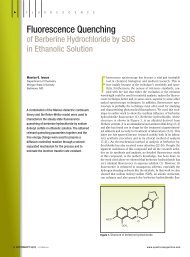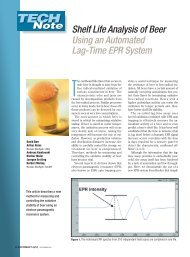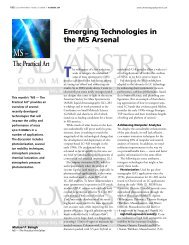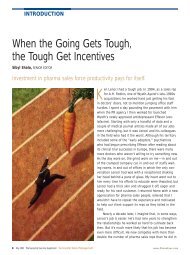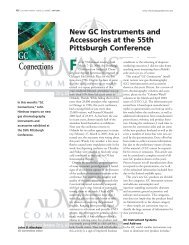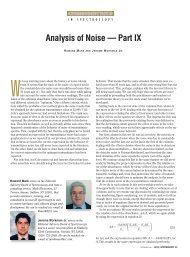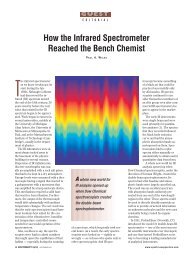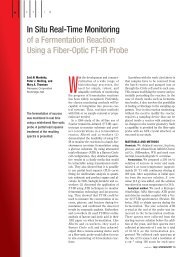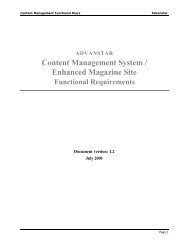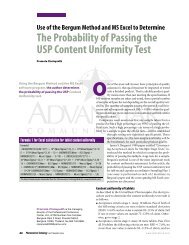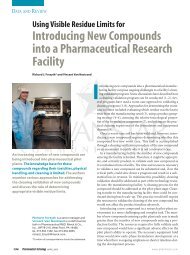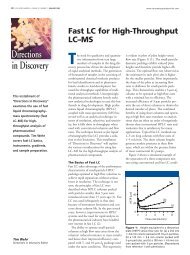Analysis of Noise â Part V - Spectroscopy
Analysis of Noise â Part V - Spectroscopy
Analysis of Noise â Part V - Spectroscopy
Create successful ePaper yourself
Turn your PDF publications into a flip-book with our unique Google optimized e-Paper software.
...........................<br />
CHEMOMETRICS IN SPECTROSCOPY ............................<br />
small compared with the reference signal, and therefore the signalto-noise<br />
ratio (S/N) was high. We then noted that if that condition<br />
did not hold for any particular set <strong>of</strong> measurements, then other phenomena<br />
also come into action. We pointed out that under low-noise<br />
conditions the signal can affect the noise level, but under conditions<br />
in which the signal is weak or the noise excessive, the noise can affect<br />
the computed transmittance as well. The expressions we obtained<br />
showed that as the reference signal gets weaker and weaker<br />
(or the noise gets larger and larger), the system first reaches a<br />
point at which the expected value <strong>of</strong> T is larger than E s<br />
/E r<br />
, and as<br />
the reference signal continues to decrease, the multiplying factor<br />
first goes through a maximum and then decreases so that the expected<br />
value <strong>of</strong> T approaches zero as the reference signal energy,<br />
E r<br />
, approaches zero.<br />
We are now ready to consider the behavior <strong>of</strong> the noise under<br />
conditions in which it is not small compared with the signal.<br />
We start with the definition <strong>of</strong> transmittance, as we pointed out<br />
previously, and we rewrite the equation here:<br />
T E s /E r [6]<br />
To put equation 6 into a usable form under the conditions we<br />
wish to consider, we could start from any <strong>of</strong> several points <strong>of</strong> view:<br />
the statistical approach <strong>of</strong> Hald (11), for example, which starts from<br />
fundamental probabilistic considerations and also derives confidence<br />
intervals (albeit for various special cases only); the mathematical<br />
approach (12) or the Propagation <strong>of</strong> Uncertainties approach<br />
<strong>of</strong> Ingle and Crouch (13). Inasmuch as any <strong>of</strong> these starting points<br />
will arrive at the same result when done properly, the choice <strong>of</strong> how<br />
to attack an equation such as equation 6 is a matter <strong>of</strong> familiarity,<br />
simplicity, and, to some extent, taste. We, being chemists and spectroscopists,<br />
and writing for spectroscopists, will use the Propagation<br />
<strong>of</strong> Uncertainties approach <strong>of</strong> Ingle and Crouch:<br />
[64]<br />
Note that we use the letters C,D to represent the variables in equation<br />
64 to avoid confusion with our usage <strong>of</strong> A to mean absorbance.<br />
Applying this to equation 6:<br />
and apply first, the theorem that Var (A B) Var (A) Var (B):<br />
and then the theorem that Var (aX) a 2 Var (X):<br />
and continue as before by setting E s<br />
E r<br />
E:<br />
and finally take square roots to obtain:<br />
[68]<br />
[69]<br />
[70]<br />
[71]<br />
This is clearly a function <strong>of</strong> both E r and E s ; in the regime we are<br />
concerned with in this column, however, as E r approaches zero, the<br />
second term under the radical dominates the expression, although<br />
clearly the point at which the numerical value becomes large compared<br />
to 1/E r 2 will depend on the value <strong>of</strong> E s as well, or equivalently,<br />
the transmittance <strong>of</strong> the sample. Here, again, therefore, the<br />
behavior <strong>of</strong> the noise <strong>of</strong> the transmittance must be expressed as a<br />
family <strong>of</strong> curves. Figures 7 and 8 present the behavior <strong>of</strong> this family<br />
<strong>of</strong> curves as functions <strong>of</strong> E r and E s , respectively.<br />
Note that equation 71 can be reduced to equation 19 (2), which is<br />
appropriate when the signal-to-noise ratio is high and may be considered<br />
constant. Under these conditions E r is large and the second<br />
term under the radical is small and the first term under the radical,<br />
which is independent <strong>of</strong> E s , dominates; then the noise <strong>of</strong> the trans-<br />
As usual, we take the variance <strong>of</strong> this:<br />
[65]<br />
[66]<br />
Figure 8. Relative noise<br />
level (SD(T )) as a function<br />
<strong>of</strong> E s at the lowsignal<br />
limit according to<br />
equation 71, for values <strong>of</strong><br />
E s between 0 and 1. The<br />
lower plot (b) is an expansion<br />
<strong>of</strong> the upper<br />
plot (a).<br />
[67]<br />
APRIL 2001 16(4) SPECTROSCOPY 35



